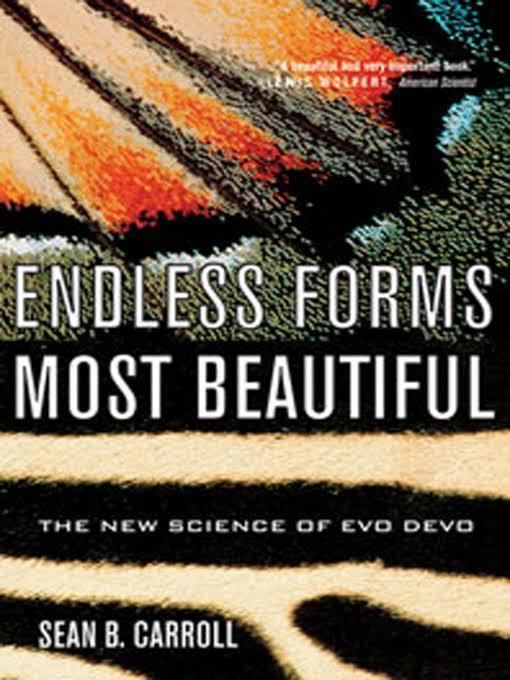8 /10 1 Votes8
Genre Popular science Publication date 2005 Originally published 2005 Page count 331 | 4/5 Goodreads Publisher W. W. Norton Pages 331 Country United States of America | |||||||||||||||||||||||||||||||||
 | ||||||||||||||||||||||||||||||||||
Subject Evolutionary developmental biology Similar Sean B Carroll books, Evolution books | ||||||||||||||||||||||||||||||||||
Endless Forms Most Beautiful: The New Science of Evo Devo and the Making of the Animal Kingdom is a 2005 book by Sean B. Carroll. It presents a summary of the emerging field of evolutionary developmental biology and the role of toolkit genes. It has won numerous awards for science communication.
Contents
The book's argument is that evolution in animals (though no doubt similar processes occur in other organisms) proceeds mostly by modifying the way that regulatory genes, which do not code for structural proteins (such as enzymes), control embryonic development. In turn, these regulatory genes turn out to be based on a very old set of highly conserved genes which Carroll nicknames the toolkit. Almost identical sequences can be found across the animal kingdom, meaning that toolkit genes such as Hox must have evolved before the Cambrian radiation which created most of the animal body plans that exist today. These genes are used and reused, occasionally by duplication but far more often by being applied unchanged to new functions. Thus the same signal may be given at a different time in development, in a different part of the embryo, creating a different effect on the adult body. In Carroll's view, this explains how so many body forms are created with so few structural genes.
The book has been praised by critics, and called the most important popular science book since Richard Dawkins's The Blind Watchmaker.
Context
The title quotes from the last sentence of Charles Darwin's 1859 The Origin of Species, in which he described the evolution of all living organisms from a common ancestor: "endless forms most beautiful and most wonderful have been, and are being, evolved."
Contents
Illustrations
The book is illustrated with photographs, such as of developing fruit fly embryos dyed to show the effects of toolkit genes, and with line drawings by Jamie W. Carroll, Josh P. Klaiss and Leanne M. Olds.
Awards
Reception
The evolutionary biologist Lewis Wolpert, writing in American Scientist, calls Endless Forms Most Beautiful "a beautiful and very important book." He summarizes the message of the book with the words "As Darwin's theory made clear, these multitudinous forms developed as a result of small changes in offspring and natural selection of those that were better adapted to their environment. Such variation is brought about by alterations in genes that control how cells in the developing embryo behave. Thus one cannot understand evolution without understanding its fundamental relation to development of the embryo." Wolpert notes that Carroll intended to explain evo-devo, and "has brilliantly achieved what he set out to do."
Jerry A. Coyne, writing in Nature, describes the book as for the interested lay reader, and calls it "a paean to recent advances in developmental genetics, and what they may tell us about the evolutionary process." For him, the centrepiece is "the unexpected discovery that the genes that control the body plans of all bilateral animals, including worms, insects, frogs and humans, are largely identical. These are the ‘homeobox’ (Hox) genes". He calls Carroll a leader in the field and an "adept communicator", but admits to "feeling uncomfortable" when Carroll sets out his personal vision of the field "without admitting that large parts of that vision remain controversial." Coyne points out that the idea that the "‘regulatory gene’ is the locus of evolution" dates back to Roy Britten and colleagues around 1970, but was still weakly supported by observation or experiment. He grants that chimps and humans are almost 99% identical at DNA level, but points out that "humans and chimps have different amino-acid sequences in at least 55% of their proteins, a figure that rises to 95% for humans and mice. Thus we can't exclude protein-sequence evolution as an important reason why we lack whiskers and tails." He also notes that nearly half of human protein-coding genes do not have homologues in fruit flies, so one could argue the opposite of Carroll's thesis and claim that "evolution of form is very much a matter of teaching old genes to make new genes."
The review in BioScience noted that the book serves as a new Just So Stories, explaining the "spots, stripes, and bumps" that had attracted Rudyard Kipling's attention in his children's stories. The review praises Carroll for tackling human evolution and covering the key concepts of what Charles Darwin called the grandeur of [the evolutionary view of] life, suggesting that "Kipling would be riveted."
The science writer Peter Forbes, writing in The Guardian, calls it an "essential book" and its author "both a distinguished scientist ... and one of our great science writers." The journalist Dick Pountain, writing in PC Pro magazine, argues that Endless Forms Most Beautiful is the most important popular science book since Richard Dawkins's The Blind Watchmaker, "and in effect a sequel [to it]."
Douglas H. Erwin, reviewing the book for Artificial Life, notes that life forms from fruit flies to man have far fewer genes than many biologists expected – in man's case, only some 20,000. "How could humans, in all our diversity of cell types and complexity of neurons, require essentially the same number of genes as a fly, or worse, a worm (the nematode Caenorhabditis elegans)?" asks Erwin. He answers his own question about the "astonishing morphological diversity" of animals coming from "such a limited number of genes", praising Carroll's "insightful and enthusiastic" style, writing in a "witty and engaging" way, pulling the reader into the complexities of Hox and PAX-6, as well as celebrating the Cambrian explosion of life forms and much else.
